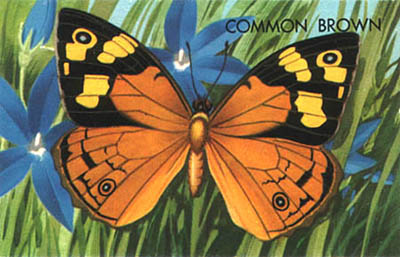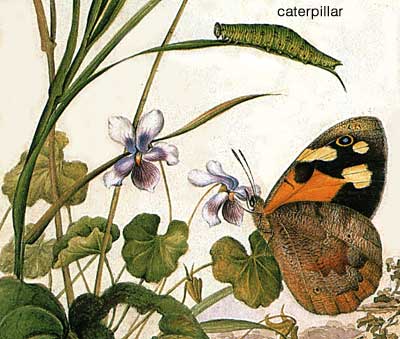![Director of National Parks [logo]](/images/dnp_90px.gif)


![Director of National Parks [logo]](/images/dnp_90px.gif) |
 |
 |
 The
Common Brown Butterfly
The
Common Brown Butterfly The Common Brown Butterfly, Heteronympha merope merope, is particularly common some years in the Canberra area, especially in the Botanic Gardens. The adults appear each year in late November and early December and can be seen flying throughout the summer. The caterpillars feed over the winter on grasses; soft young grass when they are young and later on the spring flush of grass. They feed on both native and introduced grasses and do not seem to be specific about the type of grass. Because of this they have adapted well to the suburbs of cities and towns and are common garden butterflies.
The species occurs naturally in eastern Australia from eastern central Qld to the Flinders Ranges and the Eyre Peninsula in South Australia. A subspecies is found in Tasmania. Another subspecies in south western Australia is fairly different and could possibly behave as a separate species were the populations to come into contact in the future.
The female, shown here, differs from the male in being larger (wing-span 6 cm) with some yellow rather than brown spots towards the tip of the forewing. It also has a darker underside to the hindwing.
The species was first recorded for science by Banks and Solander at Botany
Bay on Cook's first voyage in May 1770. It is one of the few insects that must
have come from Botany Bay and could not have been collected at Cooktown.
 The
Common Brown Butterfly has an interesting biology. Depending on the climate
the females delay the development of their ovaries sometimes for as long as
4 months. They may also aestivate, that is, hide away during the heat of the
summer; a reverse hibernation. In Canberra males and females emerge from the
pupa mostly in early December. Males may be seen flying sometimes until February.
Females may be seen throughout summer through into April. Egg laying takes place
mostly during March. The females are able to store seminal fluid for months
and fertilise their eggs as they lay them sometimes months after all the males
have died. In hotter environments, say West Wyalong, NSW, males and females
emerge at about the same time in early November but very few females can be
seen. By January very few males are surviving and very few females can be seen
and the females that can be found all have undeveloped ovaries and have all
mated. In late March there are no males but many females and all have developed
ovaries and are laying fertile eggs. A few females can survive to the end of
May. The females avoid the extremely desiccating conditions of summer by aestivating
and do not lay eggs until the rains of autumn have improved the quality of the
available grass.
The
Common Brown Butterfly has an interesting biology. Depending on the climate
the females delay the development of their ovaries sometimes for as long as
4 months. They may also aestivate, that is, hide away during the heat of the
summer; a reverse hibernation. In Canberra males and females emerge from the
pupa mostly in early December. Males may be seen flying sometimes until February.
Females may be seen throughout summer through into April. Egg laying takes place
mostly during March. The females are able to store seminal fluid for months
and fertilise their eggs as they lay them sometimes months after all the males
have died. In hotter environments, say West Wyalong, NSW, males and females
emerge at about the same time in early November but very few females can be
seen. By January very few males are surviving and very few females can be seen
and the females that can be found all have undeveloped ovaries and have all
mated. In late March there are no males but many females and all have developed
ovaries and are laying fertile eggs. A few females can survive to the end of
May. The females avoid the extremely desiccating conditions of summer by aestivating
and do not lay eggs until the rains of autumn have improved the quality of the
available grass.
Ted Edwards 2001
CSIRO Entomology
Canberra
Illustration 1 courtesy of
The Shell Company of Australia Ltd
© Shell Company of Australia Ltd
Illustration 2 extracted from a larger plate by Helena Scott 1832-1910